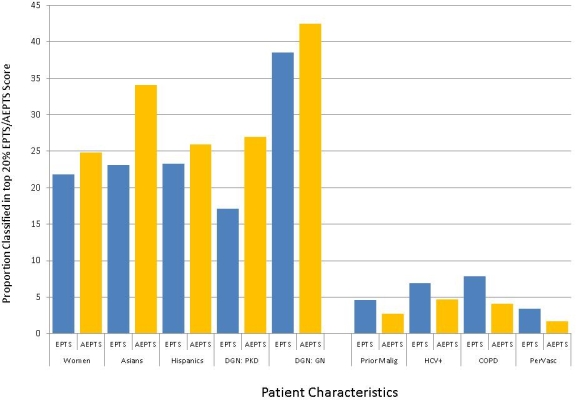The Simplified EPTS Score: Who Wins and Who Loses?
Cleveland Clinic, Cleveland, OH.
Meeting: 2016 American Transplant Congress
Abstract number: C85
Keywords: Allocation, Kidney transplantation, Multivariate analysis, Public policy
Session Information
Session Name: Poster Session C: Economics, Public Policy, Allocation, Ethics
Session Type: Poster Session
Date: Monday, June 13, 2016
Session Time: 6:00pm-7:00pm
 Presentation Time: 6:00pm-7:00pm
Presentation Time: 6:00pm-7:00pm
Location: Halls C&D
The New Kidney Allocation System includes provisions that candidates with EPTS score in the lowest 20% (indicating best expected survival) have access to the highest quality deceased donor kidneys. The EPTS score is based on only four factors (diabetic status, prior transplant, age and dialysis time), which are considered to explain patient risk with limited need for extensive data collection or a more complex equation. However, the tradeoff for this simplified equation may be that candidates with differential risks based on other known risk factors may be either disproportionally advantaged or disadvantaged. We utilized national SRTR data(2008-2015) to characterize patients that would be re-classified as high or low risk (top 20% vs lower 80%) using an Adjusted EPTS score (AEPTS) incorporating additional risk factors.
Over the study period, among 15,805 candidates in the top 20% based on the current EPTS score, 2015(11%) were reclassified into the bottom 80% with AEPTS. Conversely, 11% of candidates (n=2005) in the top 20% based on AEPTS were ranked in the bottom 80% with the current EPTS score. Characteristics associated with greater likelihood to be classified as top 20% with the AEPTS score included females, Asians, and polycystic kidney disease and glomerulonephritis diagnoses. Conversely, patients with documented comorbidities including peripheral vascular disease, prior malignancies and cerebrovascular disease, COPD and low BMI were significantly less likely to be classified in the top 20% with the AEPTS.
Although there may be tradeoffs with more complex assessments of candidate viability and certain factors may represent complex or unknown etiology of risk, these results suggest a significant portion of the candidate population may be denied access or given disproportionate access to high quality kidneys by ignoring risk factors. Given the significant association of long-term prognosis with deceased donor quality and the technological capacity to readily integrate multiple factors, some consideration for utilizing a more robust assessment of candidate viability should be considered.
CITATION INFORMATION: Schold J, Poggio E, Fatica R, Flechner S, Buccini L, Goldfarb D. The Simplified EPTS Score: Who Wins and Who Loses? Am J Transplant. 2016;16 (suppl 3).
To cite this abstract in AMA style:
Schold J, Poggio E, Fatica R, Flechner S, Buccini L, Goldfarb D. The Simplified EPTS Score: Who Wins and Who Loses? [abstract]. Am J Transplant. 2016; 16 (suppl 3). https://atcmeetingabstracts.com/abstract/the-simplified-epts-score-who-wins-and-who-loses/. Accessed December 18, 2025.« Back to 2016 American Transplant Congress
